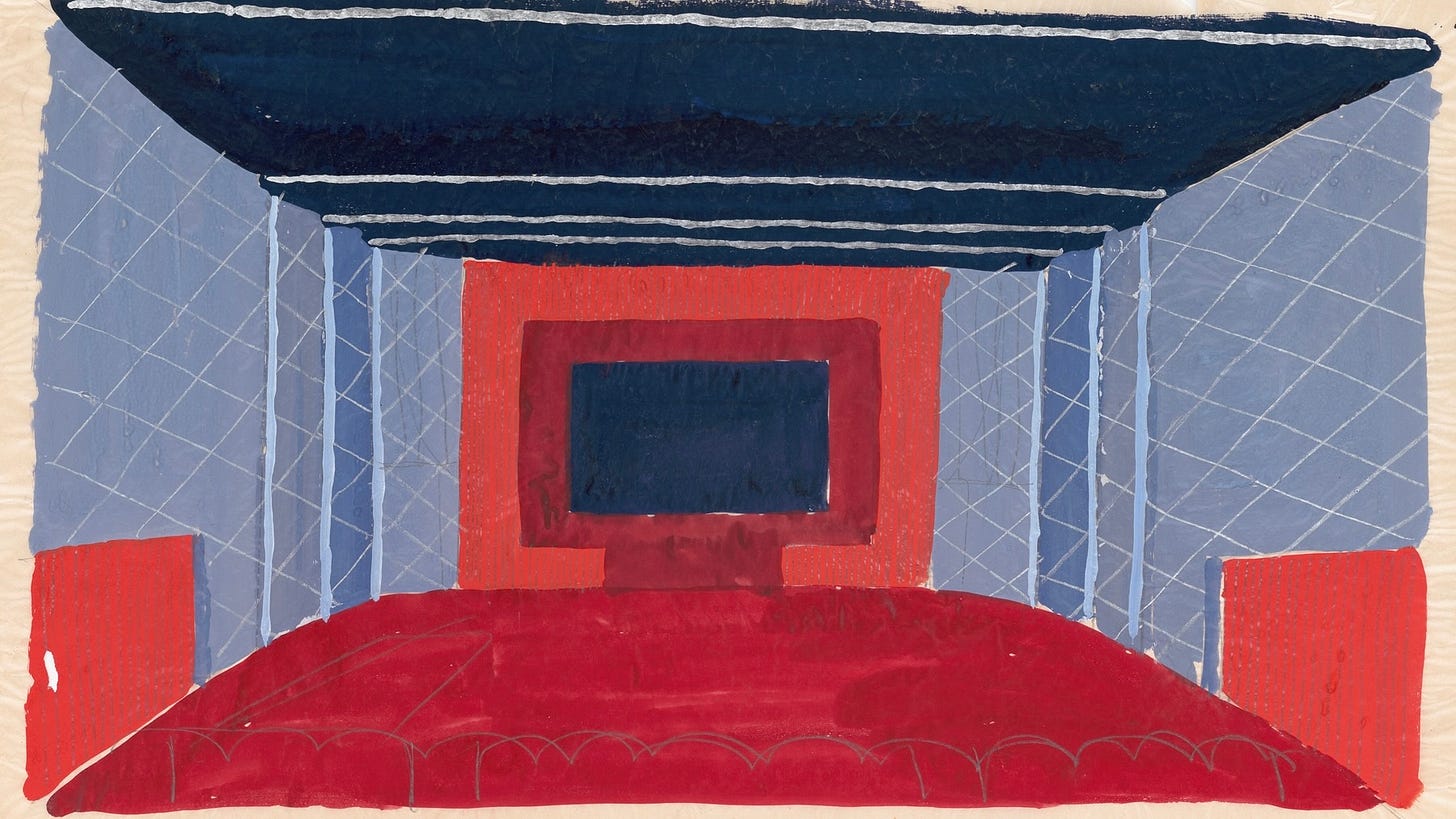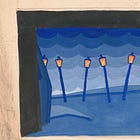Matthew Gasda is a playwright and essayist whose 2022 play, Dimes Square, launched a thousand trend pieces. His latest play, Denmark, is playing at the Brooklyn Center for Theater Research through October 20. Get your tickets here.
Today, Gasda writes in response to Katherine Dee’s recent WoC essay, “No, Culture is Not Stuck,” which has also stirred the pot.
Santiago Ramos, executive editor
“We’re witnessing the rise of new forms of cultural expression. If these new forms aren’t dismissed by critics, it’s because most of them don’t even register as relevant. Or maybe because they can’t even perceive them.”
If, in 1450, someone had gone around Florence saying, “No, no, no, we don’t live in a renaissance, culture is in decay,” I think it would have been possible to throw open the doors of the workshops, cathedrals, churches, and wealthy residences, and say, “Well, you know, I think you might be wrong about that. Take a look at this.” But in 2024, what do optimists see when you throw open the doors? Mr. Beast? Addison Rae? BAP? Talk Tuah?
Cultures have souls: values, goals, material and spiritual traditions. They take time to develop, if they develop at all. They require labor, development, and the gradual vetting process of time. Culture is not stuck or stagnant, if this, however gradual, maturation process is ongoing; if time is sculpting and selecting. Culture doesn’t require overnight innovation; it requires ripening, fructifying. Behind the Renaissance was hundreds of years of gradual spiritual and technical development in Europe (a vineyard is the easy metaphor); behind Internet culture is yesterday, or today, or ten seconds ago (a meth lab is a possible metaphor).
Katherine Dee is wrong: new forms, alone, don’t save a culture from lassitude and decay; new forms can be empty; new artists can be con-artists. Innovation without soul is pointless. Is innovation in the realm of porn (OnlyFans) or broadcasting (Barstool) supposed to convince cultural pessimists that they’re conventional, conservative, and blind? Digital culture that “innovates” with garbage is just finding new ways to feed us garbage; zero times zero is zero.
Displays of newness are not displays of soulfulness. Innovation must coordinate with complex cognitive processes, formal ambition, respect for tradition. High European modernism, for example, absorbed moving images and the music hall because it was an ultra-literate culture with a high level of general education and exacting standards. It wasn’t good because it made use of new media and mediums; it was good because it was able to transcend them. New ideas and phenomenologies, like types of grape, took root in cultivated soil.
I admit: there’s irrefutable historical evidence that what’s considered low culture tends to work itself up into high culture — folk art always ends up in a museum. Painters became prestigious, actors and playwrights became prestigious, jazz musicians became prestigious, novelists became prestigious. Serialized TV dramas, like The Sopranos or Mad Men, became prestigious. But in all of those cases, I would argue, high and low could mix because of specific cultural conditions: an educated, intellectually curious middle class. But those conditions do not exist today.
Charlie Chaplin wasn’t a genius because he composed in moving images, but because the moving images he composed expressed something very deep about the social purpose of “the tramp” in a mechanized age. A cultural optimist in the 1920s could walk into a movie theater and see that the ultra-new and ultra-popular was part of the same ecological process1, the same ferment, that produced Joyce, Kafka, Picasso, and Louis Armstrong.
When a culture is stagnant, or stuck, conversely, modes and mediums, high and low, past, present, and future, do not circulate; the cultural pool is still and foul. The critical optimist today can’t engage with a popular form and expect to feel deeper and wider currents passing through them. There is no Charlie Chaplin of TikTok (as far as I’m aware — I invited readers to propose candidates out) because TikTok actively cannibalizes the cognitive powers of its creators and users; TikTok — like so many digital platforms — is designed to capture attention. That’s it. It is not part of a larger ecosystem and complex civilizational ferment like jazz, fiction, architecture, dance, and painting were in 1922 or 1962 (when The Beatles, Fellini, Bergman, Sartre, Bellow, and Dylan were all popular).
In a certain fundamental sense, all cultural criticism is always a debate between optimists and pessimists — and the debate is always worth having. It’s always risky, because prognostication is impossible and blindspots are guaranteed. There was stupid shit in 1962, as in 1922; there were cultural doomers then too, but they were wrong (because those years were expressive of a polyphonic, nuanced braiding of traditional, canonical, the folk, and the radically new and technological). But the point, really, is not to be right, to score points, to guess correctly about what will be remembered. What matters is to analyze and critique the conditions under which culture exists. Is it easier or harder for originals to find an audience? Are the different regions of cultural production talking to each other? Is there cross-pollination? Is there curiosity? Are audience and artist pushing each other to greater degrees of cultivation and sophistication, or is the cycle inverted: are artist and audience making each other dumber?
Presently, I think we are experiencing the latter: a race to a semi-literate, comfortable numb nadir. Social media is actively stupifying. Culture can still be bad — stagnant, depressing, self-wounding — even if there are funny TikToks and memes about it. There are “genius” TikToks, genius memes. But so what? Are these good uses of our inborn capacity to use tools, iterate, and create? Does the present culture contribute to our collective wisdom, dignity, and pleasure? If it doesn’t, then does it really matter if it is “stuck” or not? What do semantics matter if you can’t deepen or feel or iterate yourself? If what you’re consuming poisons you? Bayer is an innovative pesticide maker.
Without clear (enough) aesthetic, and I would add, spiritual standards, you end up commending some trash for being better than other trash. There’s gambling culture, there’s video game culture, there’s meme culture. Great … ? Why should I devote any of my time to it? There’s bowling culture, Tupperware Party culture, Harry Potter culture, fan fiction culture, and Tumblr culture. I could go on forever. Presumably, NAMBLA meetings have their own culture. I’m guessing there are some brilliant innovators of the Satanic liturgy. Maybe some of them are on TikTok.
See also:
Worse, AI can produce memetic slop with greater degrees of fidelity to the human product. Dee does not cite a single example of art that I do not think could be easily produced by the slop machines.
Wisdom of Crowds is a platform challenging premises and understanding first principles on politics and culture. Join us!








Loved this essay. I think I tend to lean on this side rather than Katherine's but that may be because I can be reactionary (in the every day as well as intellectually) and talking to people aged between 19-22 regularly makes me think we are losing something quite serious when it comes to thinking and culture. When I asked my 200+ students how many of them read a book for leisure in the last year no more than 10 hands went up. This is what serious cultural decay looks like and it doesn't help when people deny it happening.
In the UK, book sales are down and the infiltration of 'celebrity authors' into the market space highlights a shrinking of desire for genuine literature and increasing numbers are reading 'graphic novel' versions of books i.e., comic book versions of the real thing. This is a problem transcending mere culture but the antecedents of our intellectual slowing can be seen in what's happening culturally. Just as my students either don't want to (or more likely) cannot read complex novels they also struggle to compose serious essays, critiques of works, and complex thoughts themselves. Relying on buzzwords to espouse their ideas the work rarely has depth or subtlety.
The rise of TikTok and other viral videos permeates not only our cultural but also our social and intellectual spheres. We see everything through the lens of how we feel with quick hits which make us feel good. There must be a link between the value of outrage culture and virality. Indeed, in the UK we see this trend even in once respectable newspapers.
We also see incidents such as the one below where people find themselves in ridiculous situations for the loss of a phone...
https://www.facebook.com/photo/?fbid=558286909922143&set=a.273934548357382
Well, I think we're talking about the 'arts' here, right?
Because if we're talking about culture then we can have a conversation about how materialism has warped our social values and priorities, and you can see this in the arts. In which case, Matt's article resonates with me far more than the observations that Katherine made.
In the real world, my main problem is making sure my child can read a novel, as the latest social panic article in The Atlantic has just informed me that this is NOT a given... https://www.theatlantic.com/magazine/archive/2024/11/the-elite-college-students-who-cant-read-books/679945/